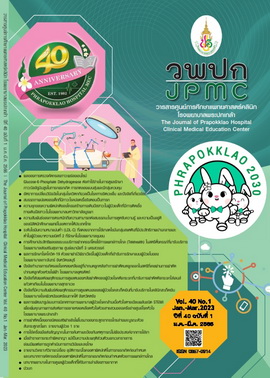Prevalence of Abnormal Ultrasonographic Findings for Pediatric Urinary Tract Infection at Burapha University Hospital
Main Article Content
Abstract
BACKGROUND: Structural abnormalities of the kidney and urinary tract in children can lead to recurrent infections and chronic kidney failure.
OBJECTIVES: To study the prevalence of abnormal ultrasonographic findings in pediatric patients with the first episode of urinary tract infections (UTI).
METHODS: A retrospective descriptive study was conducted on pediatric patients less than 15 years of age who were diagnosed with UTI at Burapha University Hospital, Chonburi Province, Thailand from January 2011 to December 2020. Baseline characteristics, ultrasound results, and recurrent infection data were analyzed by statistical tests.
RESULTS: From a total of 53 pediatric patients, the mean age at diagnosis was 2.5±2.9 years. The recurrent infection rate was 26.4% of all participants. Urinary tract abnormalities were detected in 20.8% of the ultrasound results. The three most common findings were unilateral hydronephrosis (81.8%), bladder wall thickening (9.1%), and unilateral hydronephrosis with a hydroureter (9.1%). The patients with structural abnormalities had more recurrent infections than the normal ultrasonographic results group (54.5% and 19%, respectively; p=0.02).
CONCLUSIONS: One-fifth of the patients with pediatric urinary tract infections were found to have structural abnormalities in the urinary tract and were more likely to experience recurrent urinary tract infections than those with normal ultrasound results.
Article Details

This work is licensed under a Creative Commons Attribution-NonCommercial-NoDerivatives 4.0 International License.
References
Roberts KB. Urinary tract infection: clinical practice guideline for the diagnosis and management of the initial UTI in febrile infants and children 2 to 24 Months. Pediatrics 2011;128:595-610.
Committee of Experts in the Subdiscipline of Pediatric Nephrology and Thai Pediatric Nephrology Association. Clinical practice guideline for urinary tract infections in pediatric patients aged 2 months to 5 years. Bangkok: Thai Pediatric Nephrology Association; 2014 [cited 2022 Sep 26]. Available from: http://www.kidneyforkids.org/pic/File/CPG-UTI-21102556.pdf
Sitthisarunkul N, Uthairat M, Dissaneewate P, McNeil E, Vachvanichsanong P. Characteristics and findings of childhood urinary tract infection in the last decade. Urol Int 2019; 102:456-61.
Vachvanichsanong P, Dissaneewate P, McNeil E. What did we find from imaging studies in childhood urinary tract infection and which studies are mandatory?. Urology 2018;111:176-82.
Supavekin S, Surapaitoolkorn W, Pravisithikul N, Kutanavanishapong S, Chiewvit S. The role of DMSA renal scintigraphy in the first episode of urinary tract infection in childhood. Ann Nucl Med 2013;27:170-6.
Soliman NA, Ali RI, Ghobrial EE, Habib EI, Ziada AM. Pattern of clinical presentation of congenital anomalies of the kidney and urinary tract among infants and children. Nephrology 2015;20:413-8.
Baumer JH, Jones RW. Urinary tract infection in children, National Institute for Health and Clinical Excellence. Arch Dis Child Educ Pract Ed 2007; 92:189-92.

